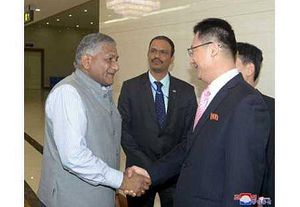As strategic equations in the Korean Peninsula undergo a dramatic shift, India too has decided to enter the fray. Last week, India’s Minister of State for External Affairs General V K Singh paid a two-day visit to North Korea. This first ministerial visit from India to North Korea in nearly two decades was at the invitation of the North Korean government, but comes at a time when developments in the region have the potential to bring in a fundamental realignment in the balance of power.
Given New Delhi’s longstanding concern regarding the role of Pakistan in helping North Korea develop its nuclear and missile programs, India during Gen. Singh’s visit underlined “the threat from nuclear proliferation, in particular India’s concerns in the context of the proliferation linkages with India’s neighborhood.” In return, Pyongyang reassured New Delhi that “as a friendly country DPRK will never allow any action that would create concerns for India’s security.” The two nations not only explored cooperation in areas such as vocational education, agriculture, pharmaceuticals, promotion of Yoga and traditional medicine, but also decided to enhance people-to-people linkages to mark 45 years of diplomatic relations.
India has had longstanding diplomatic ties with North Korea and even under pressure from the United States, it refused to reduce its diplomatic engagement with Pyongyang. North Korean Foreign Minister Ri Su-yong visited New Delhi in 2015 even as India has not been supportive of UN resolutions critical of North Korea’s human rights abuses. There have even been reports that the Center for Space Science and Technology in Asia and the Pacific (CSSTEAP) located in Dehradun had been providing technical education to North Korean scientists. During then-U.S. Secretary of State Rex Tillerson’s visit to New Delhi last year, External Affairs Minister Sushma Swaraj convinced him of the need for India to maintain a diplomatic presence in North Korea by underlining that “embassies of some of your [US] friendly countries should remain there so that some channels of communication remain open. Many times, you may have need to talk… a mutual dialogue may be required to resolve some issues. At least one embassy should be there from your friends.”
But that was a different phase in U.S.-North Korean relations when antagonistic rhetoric between the two was at an all time high. Gen. Singh’s visit this week was preceded by a cooling of temperatures on both sides. Last month, North Korean leader Kim Jong-un held a historic summit with the South Korean President Moon Jae-in where the two sides promised peace and denuclearization. This led to the announcement of a U.S.-North Korea summit in Singapore on June 12. U.S. Secretary of State Mike Pompeo has been to Pyongyang twice in recent weeks, making him the first American official to meet with a North Korean leader since then-Secretary of State Madeline Albright met with Kim Jong Il in 2000. Last week, Pompeo returned from North Korea with three Americans who had been detained by the North Korean regime.
Against this backdrop, New Delhi too seems to be reaching out to North Korea, hoping to reset trade ties with the hermit kingdom, which were hit after the sanctions that were imposed by the United States and the United Nations for North Korea’s nuclear and ballistic missile tests. Though India has been North Korea’s second largest trading partner after China, bilateral trade came down to around $130 million in 2016-17 from around $209 million in 2014-15. Last year in April, India had banned all trade with North Korea, except for food and medicines, in line with the United Nations sanctions provisions. New Delhi also toughened its stance on North Korea’s nuclear and missile provocations. This was as much due to India’s ties with the United States as it was due to India’s own concerns regarding the threat of proliferation in its own extended neighborhood. India’s ties with Japan and South Korea also meant that New Delhi couldn’t turn a blind eye of Pyongyang’s belligerence. Now as the United States, South Korea, and Japan all are trying to engage Pyongyang, India too is making a move.
But North Korea can be highly unpredictable. Just as Gen. Singh was in the country, tensions on the Korean peninsula have been increasing with North Korea threatening that it might pull out of the summit meeting with Donald Trump if the United States insists it give up its nuclear weapons. This was in response to U.S. National Security Advisor John Bolton suggesting that North Korea could follow a “Libya model” of verifiable denuclearization. This would be unacceptable to the North Korean regime, which is all too aware that Libya’s leader Colonel Muammar Gaddhafi was killed by Western-backed rebels a few years after he gave up his nuclear weapons program. North Korea also pulled out of a meeting scheduled with South Korea after the start of U.S.-South Korea joint military drills — known as Max Thunder — describing them as provocative and preparation for a future invasion. The United States and South Korea, on the other hand, have insisted the drills are purely for defense purposes, and part of their 1953 mutual defense agreement.
A stable and peaceful Korean peninsula is in India’s interest and New Delhi had welcomed recent initiatives in this regard by regional powers. But India also has its own equities to preserve in North Korea. As Pyongyang opens up to the world, India as a rising regional power should be willing to make the most of the opportunities this might offer.

































